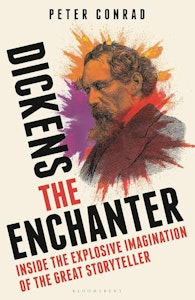This article is taken from the March 2025 issue of The Critic. To get the full magazine why not subscribe? Right now we’re offering five issues for just £10.
At Christmas, Charles Dickens liked to perform a trick called The Pudding Wonder. As friends and family gathered around the table, he picked up a top hat, in which he pledged to bake a plum pudding before their very eyes.
He would first secretly sweep into the hat an already cooked pudding in a topless tin. As his guests looked on, he took a larger tin, mixed the ingredients in it, and tipped it into the hat. As he did so, he swiftly lowered the tin into the hat so that the smaller tin was lifted out, stuck to the batter of the larger. The baked pudding would be left inside the hat. Warming the object over a candle flame helped the pudding to plop out, to everyone’s astonishment.
One senses that Charles Dickens would not have resented being forever associated with Christmas. If he liked to play sorcerer at that time of year, when “all common things become uncommon and enchanted to me”, he certainly did not demur from working his magic all year round.
Like many readers, I turn to his books principally in the winter months, beginning with A Christmas Carol or another of the Christmas stories during Advent, and branching out to whatever then takes my fancy. This December I found an alternative companion in Peter Conrad’s new book, an extended work of literary criticism, which presents Dickens at his most sorcerous.
Through Conrad’s reading one well appreciates Dickens’s capacity for finding magic everywhere. Visiting a Soho bazaar as a child in around 1815, he requested a harlequin’s wand as a present, hoping to use it to transform his strict older companion “into anything agreeable”. The wand failed (if it existed outside his imagination at all) but the child soon found sources of wonderment elsewhere.
At the age of eleven he was taken out of school to work while his parents served time in a debtors’ prison
In his adult years he would be so impressed by the speed with which the express train could transport Londoners to Paris (in just 12 hours) that he christened its engine “Compact Enchantress”. Words, of course, hold endless potential for spell-casting. Conrad’s passages on Dickens’s “verbal sorcery” — from his neologisms and names to his spooling lists and onomatopoeic exclamations — are some of his finest.
Conrad begins and ends his book with an invitation that Dickens sent a friend and his family in 1844 to celebrate his birthday on 7 February. Dickens’s closeness to the man in question gave him the confidence to be haughty. “On this day two and thirty years ago,” he wrote, “the planet Dick appeared on the horizon.” Dickens generally went by the penname Boz, an unlikely contraction of Moses (which uttered through the nose produces “Boses”, the nickname of his brother Augustus), but “planet Dick” sounded more august.
In Conrad’s view, which is well justified, Dickens “was truly entitled to call himself a planet, because he moulded his own eccentric microcosm, an outlandish asteroid that can only be called Dickensian”.
Running with that image, Conrad leads us through Dickens’s aerial perspective on the world, from a literal balloon ride over the London skyline to the “cosmic prospect” of A Tale of Two Cities and the constellations which bespeckle Our Mutual Friend. The flow of ideas, sometimes rapid, sometimes languid, gives the book the propulsion it otherwise lacks. Readers more accustomed to biography may find this work slow, but it is never dense, never dull. Conrad’s writing on Dickens’s own is to savour.

Conrad’s passion for Dickensian prose began in his childhood in Australia in the 1960s and developed during his student days as a Rhodes scholar at Oxford. Deemed too “unacademically modish” for the reading lists, like anything written before 1832, Dickens’s novels were unwittingly revivified in the colleges. As Conrad writes, the “dotty social misfits, braying patricians and slyly mock-deferential servants” of Dickens’s pages were abundantly in evidence in the university city.
Conrad stops short of repeating George Bernard Shaw’s declaration that Dickens’s collective novels are “a Bible, in fact”. The magical and arcane, even the pagan, take them somehow beyond the earthly realm. “Although Dickens deferred to the will of the Biblical God,” Conrad writes, “his world was actually ruled by the caprices of the deity he called ‘the great magician’.” We find here paragraphs on the Merchant Abudah and Arabian Nights and the tutelary spirits of pagan Britain (especially the city of Bath) in The Pickwick Papers.
Driving these interests, in part, was Dickens’s eagerness for escapism. His fiction, as Conrad puts it, “was his flight from the real, and from himself”. What is interesting is how often Dickens fell back upon his own life in spite of this desire for change.
At the age of just eleven he was taken out of school to work in a warehouse, pasting labels to bottles while his parents served time in the Marshalsea debtors’ prison. Released a year later, when they were in receipt of a financial legacy, Dickens’s parents retrieved their son — in his mother’s case reluctantly. Dickens revealed nothing of the episode until his memoir of 1847. The harshness of childhood and cruelty of parents had already become prevailing themes in his work. Mrs Clennam of Little Dorrit, published a few years later in 1855–7, is one of his most memorable creations
Dickens struggled in practice to escape the shadows of his past. As a father of ten — Virginia Woolf mocked his literal and literary fecundity — he later despaired of the imposition that parenting placed on his own life. Conrad reminds us that Dickens kept ravens as pets — one was the model for Barnaby Rudge’s Grip — and even wrote a set of articles in a raven’s persona. He apparently made no objection to the birds biting his children’s ankles.
According to Elizabeth Barrett Browning, he used “his genius as a cudgel”. His attempts to commit his wife Catherine to an asylum for “a mental disorder” are well documented. Less well known is his insistence upon terrorising her with readings of the most disturbing passages from his books, including Sikes’s murder of Nancy in Oliver Twist.
In fact, such was Dickens’s faith in his ability to terrify that he once wrote to a government minister with a bid to be what Conrad describes as “a nocturnal terrorist, inciting nightmares as a public service”. The novelist felt sure that he could write a fictional account about the punishments endured in one of Australia’s penal colonies to deter would-be criminals in England. The minister did not take up the offer.
Dickens the Enchanter is full of surprising details such as these. That Margaret Thatcher gave President Mitterrand a first edition of A Tale of Two Cities upon the bicentenary of the French Revolution was not the only anecdote to make me smile. If Dickens was a unique enchanter, alert to the magic as well as the misery of this world, Conrad is a charmingly bewitched conjurer of his genius.







